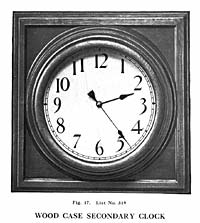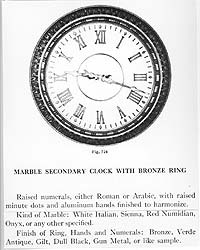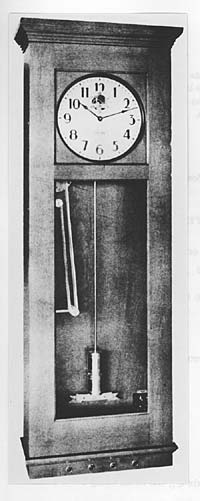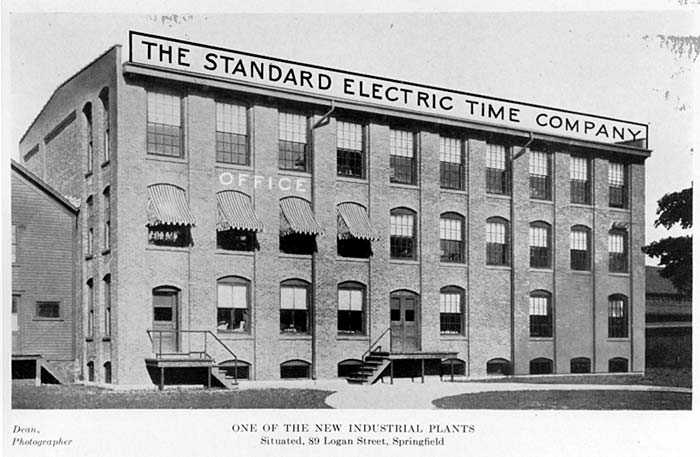
The pictures in this category were all taken circa the 1920's by or for The Standard Electric Time Company and the Pacific Electric Clock Company, the latter having been acquired by Standard in 1923. It should be noted that the earlier production of Pacific is composed of parts unique to that company (although they obviously copied certain "Standard" design features), while later production contains components supplied by Standard, such as pendulums and pilot clocks.
You may click on any image to bring up a large version.

Three-circuit Master Clock with two four-circuit Program Clocks in base, as installed at Malden (Massachusetts) High School.
From Bulletin No. 11, January, 1909.

Special Master Clock with four-circuit Switchboard and four-circuit Program Clock in base, as installed at Everett (Massachusetts) High School. Earliest known example of "Eyebrow" style case, having flat-top door.
From Bulletin No. 11, January, 1909.

Fig. 17 List No. 319
From Catalog No. 32, January, 1910. A later, plainer version of the "No. 4 Secondary Clock".

Fig. 15 Oak
Winding batteries in same case.
From Catalog No. 32, January, 1910.

Fig. 578 Oak
Metal ball pendulum. Oak case
From Catalog No. 32, January, 1910. "This 80-beat clock proves a popular, inexpensive one for controlling for controlling Time Stamps". Height, 36 1/2".

Fig. 34 List No. 208
Catalog No. 32 illustration of a very early 4-circuit, 12-hour program instrument. Movement is mounted on a cast iron frame. Later cases were made with a solid wood side door having no glass and front door glass extending to bottom of door frame.

Fig. 718 Hall Clock
These clocks are only made to order from special designs. The above design is shown merely as a typical example and not as a standard type.
From Catalog No. 32, January, 1910.

Fig. 724
Raised numerals, either Roman or Arabic, with raised minute dots and aluminum hands finished to harmonize.
Kind of Marble: White Italian, Sienna, Red Numidian, Onyx, or any other specified.
Finish of Ring, Hands and Numerals: Bronze, Verde, Antique, Gilt, Dull Black, Gun Metal, or like sample.
From Catalog No. 32, January, 1910.

Fig. 126 List No. 560
Dial 12" Case 15 1/2"
The seconds-beat clock with ticker attachment shown in Figure 126 is a very useful device for science departments in high schools and colleges, as well as for operating rooms in hospitals. It is operated from the master clock through a seconds ticker attachment actuated by the pendulum. Switches are provided for starting or stopping either the hands or the sounder independently.
From Catalog No. 42, circa 1926. Timer, first model. Contains ordinary 24 volt straight impulse secondary movement with extended center arbor. Depressing plunger at top left releases driving mechanism, permitting manual reset to zero by twisting knob protruding from center of glass.





Situated, 89 Logan Street, Springfield
Factory of the former Pelley Toilet Tissue Company as it appeared when purchased by George L. Riggs. Photo obviously retouched to include sign. Actual sign was probably done in gold leaf on a black smalted background. From WESTERN NEW ENGLAND magazine, December, 1912.


~ ~ ~ ~ ~ ~ ~ ~ ~ ~ ~ ~
Jeffrey R. Wood, creator of the Standard Electric Time Co. (SETCO) pages of clockhistory.com, passed away in August of 2018. I will maintain the SETCO web pages in honor of Jeff, but will not be making any additions or changes, or answering any questions. It is hard to express how much I miss Jeff, his friendship, and his wonderful contributions to Standard Electric and Westclox research.
Bill Stoddard